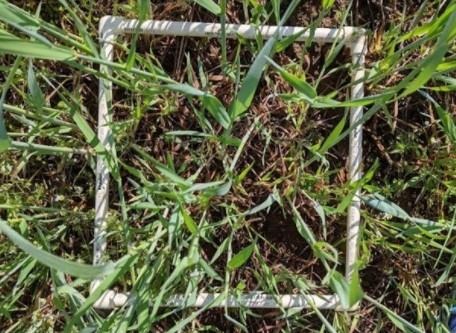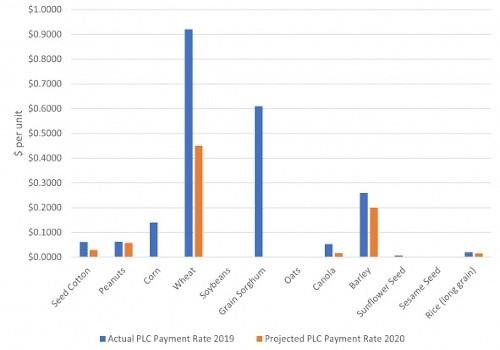One planting strategy that can expand the cover crop seeding window for farmers is broadcasting seed into standing soybeans. Success with this type of broadcast seeding using fertilizer spreaders has been noted by some farmers, and it can buy additional weeks for cover crop growth, but best practices have not been established for this area.
So, in 2020 the Pennsylvania Soybean Board On-Farm Network added a study to evaluate the feasibility of this practice in five locations. Sites included 3 cooperating farms (Montgomery, Potter, and York Counties) and the two Penn State research farms (Lancaster and Centre Counties). Nine cover crop species were included at research farms, including: cereal rye, winter wheat, annual ryegrass, rape, forage radish, balansa clover, crimson clover, red clover, and hairy vetch. Cooperating sites chose their desired species. No cover, "control" plots were also included at all sites, and species "treatments" were replicated four times at each location.
Broadcast seeding method varied by location from hand seeding to commercial scale equipment. Targeted seeding was after R6 and before leaf drop but, seeding occurred at leaf drop at SEAREC and the Potter County sites. Seeding dates ranging from September 22 to October 6, 2020, and farmers gained between 16 and 56 days of cover crop growth by using this method compared to drilling or broadcasting cover crops after soybean harvest. See table 1 for site descriptions.
Table 1. Broadcasting cover crops into soybeans study - 2020-2021 (year 1) site descriptions
| | Lancaster (SEAREC) | Centre (RELARC) | Montgomery | York | Potter |
|---|
| Soybean row spacing | 15" | 30" | 30" | 7.5" | 30" |
| Cover crop species | All | All | rape, rye, radish, crimson clover, vetch | balansa clover, crimson clover, rye | red clover, rye, wheat |
| Equipment used to establish cover crop | Chest mount spreader | Chest mount spreader | Chest mount spreader | Self-propelled high-clearance fertilizer spreader | 3-point hitch fertilizer spreader |
| Cover crop broadcast date | 9/22/2020 | 9/25/2020 | 10/6/2020 | 9/23/2020 | 10/2/2020 |
| Soybean harvest date | 10/8/2020 | 11/8/2020 | 11/25/2020 | 11/18/2020 | 11/6/2020 |
| Spring sampling date (within 3 days of termination | 4/14/2021 | 5/4/2021 | 4/30/2021 | 4/15/2021 | 5/14/2021 |
| Days between broadcast and harvest | 16 days | 44 days | 50 days | 56 days | 35 days |
NDVI readings were performed with handheld Trimble GreenSeeker Crop Sensors. Values range between 0 and 1 and are an indicator of "greenness" in the field; the closer the value to 1, the less bare soil and more vegetation. We use these values to indicate the success of cover crop establishment and groundcover, along with cover crop density (number of plants per square foot) (Image 1). Soil nitrate values at soybean harvest and cover crop termination, and spring aboveground biomass were also measured.

Image 1: Counting cereal rye density within a one-foot square frame at Centre County (RELARC) just before termination in May 2021.
Year One Results
On average across sites, cereal rye and winter wheat performed better than all other cover crop species, accumulating the most biomass, highest density (Figure 1), and most groundcover. Plots with cereal rye or wheat also had lower weed biomass compared to other cover crop species or the no cover crop control. However, biomass was still low compared to drilling after soybean harvest, even considering the earlier planting date; rye and wheat ranged from as low as 800 pounds per acre at Montgomery to 2,000 pounds per acre at SEAREC; the only exception was the moderate 6,000 pounds per acre of rye at York. Due to generally low biomass of covers overall, we were not surprised to see little influence on soil nitrate.

Figure 1. Representative site Lancaster (SEAREC) cover crop density (plants per square foot) measured at soybean harvest, one month later, and at cover crop termination. Grasses outperformed other species at the Lancaster site and elsewhere.
Across sites, annual ryegrass, hairy vetch, and rape did not have as successful establishment or as much biomass as cereal rye and wheat, but across sites performed better than clovers. Unfortunately, all clover species failed to overwinter at all cooperator sites, and Balansa clover did not emerge at all at RELARC. However, crimson clover was among the best performing species at SEAREC.
Conclusions
We were encouraged that we were able to seed 16-56 days earlier than we would have if waiting until after soybean harvest—but our average broadcast date was still the last week of September, later than the recommended date for most legumes, largely contributing to the failure of these species to thrive across sites. This resulted in low with those species, and moderate success with species like cereal rye and wheat, which would have likely established well with a drill after harvest anyway.
Thus, in 2022, we will target earlier planted and earlier maturing soybean fields that may be hitting maturity (our R6-leaf yellowing window) in late August or early September. This will hopefully facilitate better establishment of species other than rye and wheat.
In addition to planting earlier in September or August, we also plan to evaluate wheel-track damage and yield loss from the broadcast operation and will use commercial-scale equipment at more sites as opposed to hand-broadcasting.
Source : psu.edu